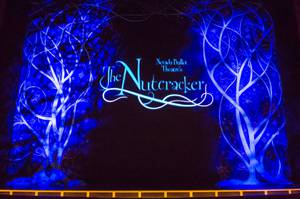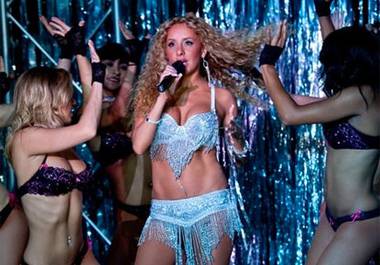It’s almost 1 a.m. and a crowd is forming amid the racks of lingerie, massage oils and exotic fetish gear.
A few doors down, something illicit is going on inside the Green Door, but this crowd is looking for a very different kind of erotic show.
Cirque du Soleil cast member Wassa Coulibaly’s The Art of Prostitution debuted at the Onyx Theatre, a 96-seat venue tucked away in the back of a sex shop in Commercial Center off Sahara Ave., on Thursday. OK, Friday morning, technically speaking: The show began at 1 a.m.
The hour-long production features a 22-member cast drawn from various productions on the Strip, which means the performers are unable to make it from their “regular day jobs,” to the theater until after midnight. After all, a sexy show about prostitution isn’t really suited for the matinée crowd.
More
- Beyond the Weekly
- Onyx Theatre
The cast is a melting pot of high-profile Vegas shows – all of which will not be named, at the performers’ request, to avoid associating their family-friendly employers’ brands with the word “prostitution.” (But feel free to Google names from the playbill or look at the billboards along the Strip and connect the dots…)
Still, the show’s choreographer and co-director doesn’t consider it to be controversial.
“We’re just exploring the different taboos of people’s sexuality,” Allan McCormick says.
Coulibaly, the driving force who wrote the 60-minute production agrees. “There’s so many types of prostitutes. Prostitution doesn’t just happen on the street corner, it happens in many forms.”
The Senegalese writer, dancer, singer and playwright considers “any love relationship that isn’t unconditional love” to be prostitution. She points to the importance of a companion’s job, bank account and social standing as motivators for more common, socially accepted forms of prostitution.
While prostitution has been a reality of modern and ancient society, the profession itself is still a big taboo – even in a town like Las Vegas. That hasn’t stopped Coulibaly from talking about it. While she herself is not a prostitute, the 32-year-old says she has faced her fair share of taboos over the years.
“I come from Senegal, West Africa and a Muslim family,” she says, describing her father as an overbearing, “square-minded” man.
“I was not his model daughter, the kind that wore a skirt and covered up,” she explains.
After 18 years of “oppression,” Coulibaly’s free spirit fled to Hawaii and then L.A. before landing a major role on the Strip in 2003.
She wrote The Art of Prostitution – her fifth production – in her downtime.
For the last six weeks the cast has met at 11 a.m. – early for Strip performers – to rehearse in Coulibaly’s home studio for three to four hours a day, five days a week.
The show was a labor of love for all involved: Coulibaly sewed the costumes herself and no one was paid to perform.
“Nobody’s doing it for money, they’re doing it for the art,” Coulibaly says.
More than an excuse to showcase their professional and physical talents onstage, Prostitution gave the performers a chance to explore and develop new characters.
“It’s a new way of expression for them, to do something new outside of their usual shows,” Coulibaly says. “For all of us, it’s so exciting to have a new challenge.”
Part of that challenge has been conveying that despite the show’s eyebrow-raising name, it’s not that kind of show.
“It’s very burlesque but it’s very spiritual in the end,” Coulibaly says. Her characters go “from repression to bliss,” from an exploited, hyper-sexualized reality to hell, before arriving at a new state of understanding and contentment.
“The whole show is about prostitution and people’s guilt concerning prostitution,” McCormick says.
The show’s musical numbers are pleasing to watch and listen to, but hardly glamorize the world’s oldest profession. In addition, a quartet of tribal elders serve as Africanized buzz-kill, repeatedly appearing onstage to chant, “shame, shame, shame!” at the scantily clad women.
“It’s all about freedom of the soul,” Coulibaly says. “We can go to the worst spot in life and find bliss. … If you accept it, you can find peace.”
The show’s more serious undertones may be lost amidst the flashes of flesh; let’s face it: It’s hard to think straight when there are seven sexy and sassy women stripping and shakin’ what their mothers (or surgeons?) gave them onstage.
Still, Prostitution serves up both Viagra and vitamins laced with messages of pride and female power in one exotic, erotic cocktail, and the audience seemed eager to appreciate. Despite a tight budget and very limited advertising, the Onyx was filled to capacity for both performances.
Eager theatergoers lined the aisles on opening night to take in the 60-minute show. Afterward, the crowd was positively abuzz – whether the buzz was over physical elements or the philosophical ones, however, is debatable.
“I’m so encouraged, so inspired,” Coulibaly said after receiving the overwhelming reception opening night. “Everybody kept coming up to me saying to me how beautiful they thought the show was. … it really was beautiful.”
Still, she acknowledges there’s work to be done. “We need to make sure the audience understands,” she says. “I think some of them might have missed the message.”







Previous Discussion: